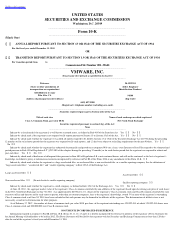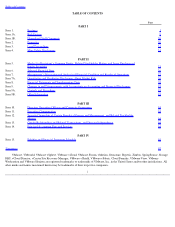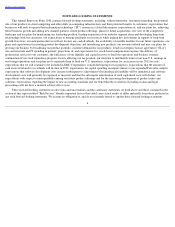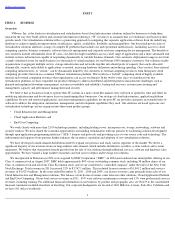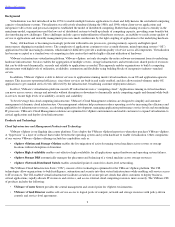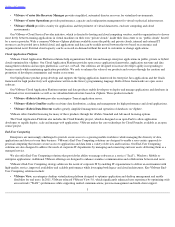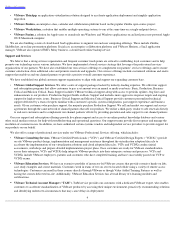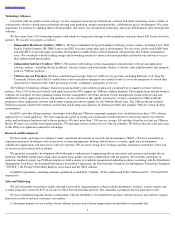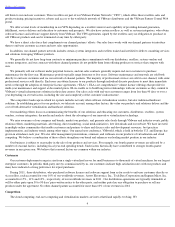VMware 2011 Annual Report Download - page 7
Download and view the complete annual report
Please find page 7 of the 2011 VMware annual report below. You can navigate through the pages in the report by either clicking on the pages listed below, or by using the keyword search tool below to find specific information within the annual report.
Table of Contents
Background
Virtualization was first introduced in the 1970s to enable multiple business applications to share and fully harness the centralized computing
capacity of mainframe systems. Virtualization was effectively abandoned during the 1980s and 1990s when client-server applications and
inexpensive x86 servers and personal computers established the model of distributed computing. Rather than sharing resources centrally in the
mainframe model, organizations used the low cost of distributed systems to build up islands of computing capacity, providing some benefits but
also introducing new challenges. These challenges include a gross underutilization of hardware resources, an inability to easily assure quality of
service to applications and unwieldy management processes made cumbersome by the tight coupling of applications to the underlying hardware.
Today, x86 hardware is becoming increasingly proficient with multi-core processors, growing memory capacity and higher speed
interconnects shipping in standard servers. The complexity of applications continues to rise as multi-element, mixed operating system (“OS”)
applications become increasingly common, which makes it difficult to provide a uniform quality of service across all components. Virtualization
has become accepted as a standard way of computing in data centers that enables highly efficient utilization of hardware.
VMware's infrastructure virtualization platform, VMware vSphere, not only decouples the entire software environment from its underlying
hardware infrastructure, but also enables the aggregation of multiple servers, storage infrastructures and networks into shared pools of resources
that can be delivered dynamically, securely and reliably to applications as needed. This approach enables organizations to build a computing
infrastructure with high levels of utilization, availability, automation and flexibility using building blocks of inexpensive industry-standard
servers.
In addition, VMware vSphere is able to deliver services to applications running inside virtual machines, in an OS and application-agnostic
manner. This increases operational efficiency, since these services are built-in and easily enabled, and also allows mixed-element, multi-OS
applications to get standard service levels delivered by the infrastructure, broadening customer deployment choices.
In effect, VMware's virtualization platform converts IT infrastructure into a “computing cloud.” Applications running in virtual machines
can move across servers, storage and networks without disruption or downtime to dynamically match computing supply and demand while built-
in services ensure high levels of availability, security and scalability.
To best leverage this cloud computing infrastructure, VMware's Cloud Management solutions are designed to simplify and automate
management of dynamic cloud infrastructure. Our management solutions help customers reduce operating costs by increasing the efficiency and
availability of infrastructure resources, accelerating application development, managing application performance service levels and streamlining
IT processes. VMware's Cloud Management solutions are optimized for vSphere environments and enable customers to expand virtualization to
critical applications and deploy cloud infrastructure.
Products and Technology
Cloud Infrastructure and Management Products and Technology
VMware vSphere is our flagship data center platform. Users deploy the VMware vSphere hypervisor when they purchase VMware vSphere.
A “hypervisor” is a layer of software that resides between the operating system and system hardware to enable virtualization. Other components
of our various VMware vSphere offerings include key capabilities such as:
The VMware Cloud Infrastructure Suite ("CIS") consists of five technologies optimized for the VMware vSphere platform. The CIS
technologies allow organizations to build intelligence, automation and security into their virtual infrastructures while enabling self-
service access
to IT resources. The CIS-enabled virtual infrastructure facilitates creation of secure private clouds that allow customers to deploy business-
critical applications, rapidly allocate IT resources and services, and access external cloud computing resources more securely. The VMware CIS
of products includes the following:
2
• vSphere vMotion and Storage vMotion enables the live migration of actively running virtual machines across servers or storage
locations without disruption or downtime.
• vSphere High Availability enables cost-
effective high availability for all applications against hardware and operating system failures.
• vSphere Storage DRS
automatically manages the placement and balancing of a virtual machine across storage resources.
• vSphere vNetwork Distributed Switch enables centralized point of control for cluster-
level networking.
• VMware vCenter Server
provides the central management and control point for vSphere environments.
• VMware vCloud Director enables self-service access to logical pools of compute, network and storage resources with policy-driven
controls and service-level agreements.


